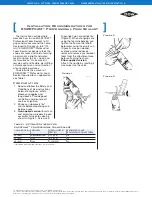
4. If the gap is overfilled, stuff
excess cured foam into the gap
with a blunt tool or trim away
with a sharp knife. Foam will be
tack-free in less than 20 minutes
and can be trimmed in 1/2 hour.
It is fully cured 1 hour after
application.**
5. Clean foam dispensing gun
periodically by rubbing the end
on soft wood to free it from
foam. Do not use a sharp object
to clean foam dispensing gun.
Use a solvent cleaner such as
gun cleaner, acetone or other
adhesive remover between
extended periods of non-use.
6. To store partially used can,
tighten flow control screw
closed and store can upright
with gun attached. Use can
within 30 days of initial use.
7. To reuse, shake can vigorously
for 1 minute before dispensing
and follow dispensing
instructions stated above.
STraw-applied verSion:
1. Attach the nozzle by twisting it
clockwise into the valve. Press
the button until the appropriate
size of foam bead is achieved.
Fill gap less than 1/3 full to
allow for proper expansion.
2. If the gap is overfilled, stuff
excess cured foam into the gap
with a blunt tool or trim away
with a sharp knife. Foam will be
tack-free in less than 20 minutes
and can be trimmed in 1/2 hour.
It is fully cured 1 hour after
application.**
3. Clean straw periodically by
rubbing the end on soft wood to
free it from foam.
4. When finished, bend the straw
back onto the plug on top of
the trigger assembly. The plug
prevents moisture from entering
and curing inside the straw or
valve.
5. To use after storage, gently
rotate or twist the straw to break
the adhesive bond of the foam.
Pull the straw off of the plug and
dispense.
c l e a n u P
• On solid surfaces, uncured
foam can be dissolved with
gun cleaner, acetone or other
adhesive remover. Cured foam
must be mechanically removed
or allowed to wear off in time.
• To clean foam dispensing gun,
install a can of gun cleaner,
acetone or other adhesive
remover to the foam dispensing
gun and spray until all foam
is blown out of the foam
dispensing gun and only cleaner
is visible (approximately half
the can of cleaner will be used).
Allow the gun to sit for several
minutes and repeat with a
second flush.
• Do not leave a can of cleaner
mounted on the foam
dispensing gun. This will
dissolve the lip seals inside
the gun and render it useless.
Foam escaping at the handle or
trigger indicates a faulty seal. If
this happens, the gun should be
replaced. If the foam dispensing
gun has not been cleaned, add
a new can of ENERFOAM™
Professional Foam Sealant
immediately. If left without a can
attached, exposure to air and
moisture will cause the foam in
the gun to cure.
d i S P o S a l
• Disposal of full or partially
used aerosol cans must be in
compliance with all federal,
state/provincial and local laws
and regulations. Regulations
vary in different locations.
Empty cans are not considered
hazardous waste and may be
disposed of an nonhazardous
household waste.
S a F e t Y a n d
c o n d i t i o n S o F u S e
• Read the label and Material
Safety Data Sheet carefully
before use.
• ENERFOAM™ Professional
Foam Sealant contains
isocyanate and a flammable
blowing agent. vapor may
travel to other rooms. Ensure
adequate ventilation. Shut off
all pilot lights and extinguish
open flames; eliminate all
sources of ignition before use.
Do not smoke or use lighters or
matches while dispensing foam.
• Do not breathe vapor or mist.
Use in well-ventilated areas
or wear proper respiratory
protection. Isocyanate is
irritating to the eyes, skin and
respiratory system, and may
cause sensitization by inhalation
or skin contact.
• ENERFOAM™ Professional
Foam Sealant is very sticky and
will adhere to most surfaces
and skin. Do not get foam
on skin. Wear long sleeves,
gloves, and goggles or safety
glasses. Cured foam must
be mechanically removed or
allowed to wear off in time.
• The contents are under
pressure. The can may burst if
left in areas susceptible to high
temperatures, such as motor
vehicles, or near radiators,
stoves or other sources of heat.
Do not place can in hot water.
Do not puncture, incinerate or
store at temperatures above
120°F (49°C).
• ENERFOAM™ Professional
Foam Sealant may be used
on vinyl, wood, composite
and metal (aluminum or steel)
substrates. The product adheres
best when surfaces are clean
and free of oil or chemicals.
• Extremely cold temperatures
can affect dispensing perfor-
mance.
• Skin of cured foam can
discolor if exposed to direct
or continuous sunlight for 24
hours or more. Foam should be
painted or coated if prolonged
exposure to sunlight is
expected.
• Using foam dispensing guns
(shown in Figure 1) simplifies
the application of ENERFOAM™
Professional Foam Sealant. In
addition to enabling pinpoint
application control, an airtight
and moisture-tight seal between
the gun and the can prevents
the foam from curing and
blocking the dispensing valve.
installation information . commercial/residential
®™Trademark of The Dow Chemical Company (“Dow”) or an affiliated company of Dow
**Dependent upon temperature, relative humidity and size of foam bead
Tip: always close the flow
control knob when the gun is
not in use.
Tip: Treat your gun like a tool.
The better you take care of it,
the longer it will last.






















